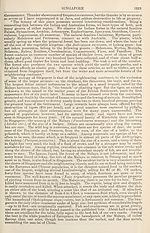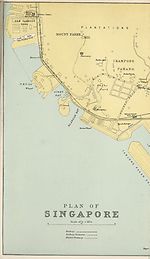1917
(1337) Page 1224
Download files
Complete book:
Individual page:
Thumbnail gallery: Grid view | List view

1224
SINGAPORE
In recent years there has been a great development of pineapple cultivation in
Singapore. Extensive areas of waste grpund covered with secondary jungle have
been cleared and planted with pineapple for tinning; the whole of this business appears
to be in the hands of Chinese. Considerable interest has also been shown in the
cultivation of rubber, oil-grasses, lemon-grass and citronella, as well as indigo,
vegetables, pepper and ground nuts. Coconut cultivation increased rapidly for a time,
but there is some tendency, especially among the Chinese, to substitute rubber for
coconut, which has been officially declared to be “not an advisable policy.”
Singapore offers but few points of salient interest to visitors, the Botanical Gardens
at Tanglin, the Wateworks in Thomson Road, and the Raffles Library and Museum
being its only show places. A considerable mileage of electric tramway is now in
operation. A railway across the island was sanctioned by a vote of the Legislative
Council in 1899, and was opened for traffic on 1st January, 1903. An extension to the
Tanjong Pagar Docks and neighbourhood was sanctioned and now runs as far as Pasir
Panjang. This line of fourteen miles was the first section of a projected Malay Peninsula
and India Railway, passing through and opening up the countries of Johore, Malacca,
the Native Malay States, some Siamese territory and Burma, on to Calcutta. The
Railway now runs direct from Singapore to Penang, and has been extended on the
West Coast into Kedah to join up with the Siamese railway system. The railway has
also been constructed from a junction at Gemas, near the northern boundary of Jphore,
through the eastern State ot' Pahang, and will eventually be extended through
Kelantan to from another link with the Siamese railway system on the East Coast.
The Singapore Railway was purchased in 1913 for £482,533 by the Federated Malay
States Government from the Colonial Government in order to unify the British Malayan
railway system under one management. There is a train ferry between the Island of
Singapore and the mainland, but plans have been prepared for the construction of a
railway bridge across the Straits of Johore, and it is proposed to make this bridge
Accessible for motor and foot traffic. The distance from Singapore to Calcutta is just
0ver 2,000 miles.
DIRECTORY
COLONIAL GOVERNMENT
Governor, and Commander-in-Chief—Sir Arthur H. Young, g.c.m.g.
Aide-de-Camp—(Officiating as) M. E. Sherwood
Private Secretary—M. E. Sherwood
Clerk—W. Bachelor
Executive Council
His Excellency the Governor, President
General Officer Commanding the Troops
Hon. Colonial Secretary
Hon. Resident Councillor of Penang
Hon. Attorney-General
Hon. Colonial Treasurer
Hon. Colonial Engineer
Clerk of Councils, E. C. H. Wolff
Legislative Council
His Excellency the Governor, President
General Officer Commanding the Troops
Hon. Colonial Secretary
Hon. Resident Councillor of Penang
Hon. Attorney-General
Hon. Treasurer
Hon. Colonial Engineer.
Hon. C. J. Saunders
Hon. Dr. W. G. Ellis
Hon. H. W. Firmstone
Hon. A. R. Adams
Hon. C. H Niven
Hon. W. W. Cook
Hon. C. W. Darbishire
Hon. J. Mitchell
Hon. F. M. Elliot
Hon. C. I. Carver
Hon. Dr. Lim Boon Keng
Clerk of Councils—E. C. H. Wolff
Shorthand Reporter—(vacant)
W. A. Wilson (acting)
(For Government Departments see under G.)
SINGAPORE
In recent years there has been a great development of pineapple cultivation in
Singapore. Extensive areas of waste grpund covered with secondary jungle have
been cleared and planted with pineapple for tinning; the whole of this business appears
to be in the hands of Chinese. Considerable interest has also been shown in the
cultivation of rubber, oil-grasses, lemon-grass and citronella, as well as indigo,
vegetables, pepper and ground nuts. Coconut cultivation increased rapidly for a time,
but there is some tendency, especially among the Chinese, to substitute rubber for
coconut, which has been officially declared to be “not an advisable policy.”
Singapore offers but few points of salient interest to visitors, the Botanical Gardens
at Tanglin, the Wateworks in Thomson Road, and the Raffles Library and Museum
being its only show places. A considerable mileage of electric tramway is now in
operation. A railway across the island was sanctioned by a vote of the Legislative
Council in 1899, and was opened for traffic on 1st January, 1903. An extension to the
Tanjong Pagar Docks and neighbourhood was sanctioned and now runs as far as Pasir
Panjang. This line of fourteen miles was the first section of a projected Malay Peninsula
and India Railway, passing through and opening up the countries of Johore, Malacca,
the Native Malay States, some Siamese territory and Burma, on to Calcutta. The
Railway now runs direct from Singapore to Penang, and has been extended on the
West Coast into Kedah to join up with the Siamese railway system. The railway has
also been constructed from a junction at Gemas, near the northern boundary of Jphore,
through the eastern State ot' Pahang, and will eventually be extended through
Kelantan to from another link with the Siamese railway system on the East Coast.
The Singapore Railway was purchased in 1913 for £482,533 by the Federated Malay
States Government from the Colonial Government in order to unify the British Malayan
railway system under one management. There is a train ferry between the Island of
Singapore and the mainland, but plans have been prepared for the construction of a
railway bridge across the Straits of Johore, and it is proposed to make this bridge
Accessible for motor and foot traffic. The distance from Singapore to Calcutta is just
0ver 2,000 miles.
DIRECTORY
COLONIAL GOVERNMENT
Governor, and Commander-in-Chief—Sir Arthur H. Young, g.c.m.g.
Aide-de-Camp—(Officiating as) M. E. Sherwood
Private Secretary—M. E. Sherwood
Clerk—W. Bachelor
Executive Council
His Excellency the Governor, President
General Officer Commanding the Troops
Hon. Colonial Secretary
Hon. Resident Councillor of Penang
Hon. Attorney-General
Hon. Colonial Treasurer
Hon. Colonial Engineer
Clerk of Councils, E. C. H. Wolff
Legislative Council
His Excellency the Governor, President
General Officer Commanding the Troops
Hon. Colonial Secretary
Hon. Resident Councillor of Penang
Hon. Attorney-General
Hon. Treasurer
Hon. Colonial Engineer.
Hon. C. J. Saunders
Hon. Dr. W. G. Ellis
Hon. H. W. Firmstone
Hon. A. R. Adams
Hon. C. H Niven
Hon. W. W. Cook
Hon. C. W. Darbishire
Hon. J. Mitchell
Hon. F. M. Elliot
Hon. C. I. Carver
Hon. Dr. Lim Boon Keng
Clerk of Councils—E. C. H. Wolff
Shorthand Reporter—(vacant)
W. A. Wilson (acting)
(For Government Departments see under G.)
Set display mode to:
![]() Universal Viewer |
Universal Viewer | ![]() Mirador |
Large image | Transcription
Mirador |
Large image | Transcription
Images and transcriptions on this page, including medium image downloads, may be used under the Creative Commons Attribution 4.0 International Licence unless otherwise stated. ![]()
| Asian directories and chronicles > 1917 > (1337) Page 1224 |
|---|
| Permanent URL | https://digital.nls.uk/194549689 |
|---|
| Attribution and copyright: |
|
|---|---|
| Description | Volumes from the Asian 'Directory and Chronicle' series covering 1917-1941, but missing 1919 and 1923. Compiled annually from a multiplicity of local sources and research. They provide listings of each country's active corporations, foreign residents and government agencies of all nationalities for that year, together with their addresses. Content includes: various treaties; coverage of conflicts; currencies and taxes; consular fees; weights and measures; public holidays; festivals and traditions. A source of information for both Western states and communities of foreigners living in Asia. Published by Hongkong Daily Press. |
|---|---|
| Shelfmark | H3.86.1303 |
| Additional NLS resources: |

